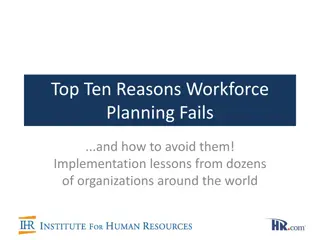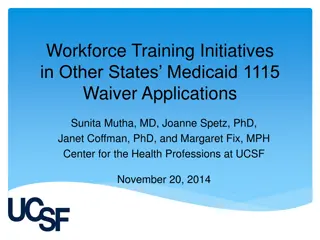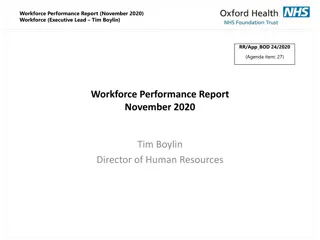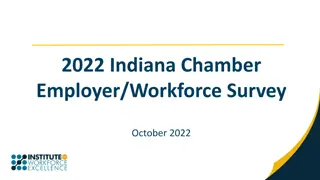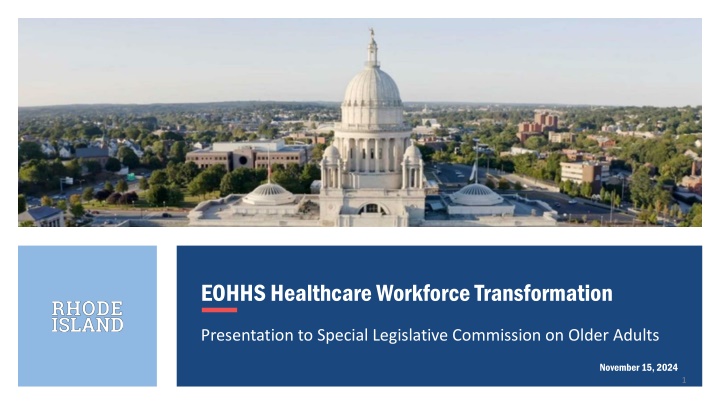
Healthcare Workforce Challenges and Initiatives in Rhode Island
Explore the workforce challenges in RI's health and human services sector, including burnout, lack of diversity, and low wages. Learn about Rhode Island's Health Workforce Planning Initiative and the impact of aging on the state's population by 2030.
Download Presentation

Please find below an Image/Link to download the presentation.
The content on the website is provided AS IS for your information and personal use only. It may not be sold, licensed, or shared on other websites without obtaining consent from the author. If you encounter any issues during the download, it is possible that the publisher has removed the file from their server.
You are allowed to download the files provided on this website for personal or commercial use, subject to the condition that they are used lawfully. All files are the property of their respective owners.
The content on the website is provided AS IS for your information and personal use only. It may not be sold, licensed, or shared on other websites without obtaining consent from the author.
E N D
Presentation Transcript
EOHHS Healthcare Workforce Transformation Presentation to Special Legislative Commission on Older Adults November 15, 2024 1
Workforce Challenges Across RIs Health and Human Services Sector Workforce Challenges Across RI s Health and Human Services Sector Pre- and post-pandemic o Emotionally & physically exhausting work o Lack of respect and recognition o Lack of racial, linguistic, and ethnic diversity, especially in the licensed workforce o Workforce stress, burnout, and turnover across all settings and occupations o Uncompetitive reimbursement rates and wages o Limited opportunities & barriers to advancement o Tight labor market ( Great Resignation ; structural shortages) All of which have adversely impacted workforce recruitment & retention AND timely access to quality care and services for older adults. 2
Rhode Islands Health Workforce Planning Initiative Rhode Island s Health Workforce Planning Initiative Launched in April 2022 by EOHHS, OPC, and DLT at Health Workforce Summit Over 600 individuals from 200+ organizations Weekly public-private sector project team meetings Workgroups and project implementation teams Quarterly online update meetings attended by 125 150 stakeholders Quarterly electronic newsletter sent to over 1,700 contacts Three annual Summits (75, 125, and 155 attendees); two attended by Governor McKee
Aging in Rhode Island Aging in Rhode Island By 2030, it is estimated that one in four Rhode Islanders will be 65 or older, while adults living with disabilities in Rhode Island account for 13 percent of the total state population, versus 12 percent nationally. 4
Direct Care Workers in Long Direct Care Workers in Long- -Term Care Term Care Nursing Assistants (CNA) Nursing Assistants (CNA) and color, and rely on some form of public assistance. color, and rely on some form of public assistance. and Home Health & Personal Care Aides (PCA) are low paid, disproportionately women of Home Health & Personal Care Aides (PCA) are low paid, disproportionately women of Nursing Assistant . Home Health & Personal Care Aide 39% of Nursing Assistant and Home Health & Personal Care Aide (combined) receive some form of public assistance. Employed Employed 8,040 8,370 Median wage Median wage $20.00/hr. $18.25/hr. White/Hispanic/Black White/Hispanic/Black 34% / 34% / 21% N/A Female/Male Female/Male 93%/7% N/A Long Long- -term care settings compete for CNAs with other settings term care settings compete for CNAs with other settings Setting Setting Earnings Earnings All long-term care $33,332 Home Care $26,340 Residential $36,632 Hospital $39,796 Government $51,076 Temporary employment $17,040 Median Age Median Age 43.4 43.9 43.2 39.8 48.8 39.2 Employment Employment 9,894 3,952 6,661 2,845 506 2,557 50% of all CNAs working in a healthcare setting work in long-term care. Growth in CNA employment (2019 Growth in CNA employment (2019- -2023) 2023): All healthcare settings: 1.4% Temporary employment: 37.2% (2,557) All healthcare settings: 1.4% Temporary employment: 37.2% (2,557) Sources: RI DLT; RI EOHHS; PHI National; All data is for 2023 unless otherwise note. 5
Direct Care Workers in Long Direct Care Workers in Long- -Term Care Term Care Thousands of actively licensed Nursing Assistants (CNA) are not working in healthcare Thousands of actively licensed Nursing Assistants (CNA) are not working in healthcare or any or any job in Rhode Island. Licensed: 17,890 Employed in a healthcare setting: 13,293 Employed in any setting: 15,400 There will be nearly 30,000 job openings for CNAs and PCAs between 2022 There will be nearly 30,000 job openings for CNAs and PCAs between 2022- - 2032. Growth Growth Nursing Assistant 944 Home Health & Personal Care Aide 1,933 2032. Exits Exits 7,465 6,025 Transfers Transfers 6,035 7,225 TOTAL TOTAL 14,444 15,183 More than 2,200 new CNAs have been licensed in the past 12 months. And yet, there are currently 288 CNA jobs posted on EmployRI. Very few CNAs go on to become Registered Nurses. Very few CNAs go on to become Registered Nurses. Of the 42,946 CNAs licensed since 2010, only 7.7% have gone on to become a Registered Nurse. This percentage is higher for White CNAs (12.3%), and lower for Black (3.9%), and Hispanic CNAs (3.2%) Sources: RI DLT; RI EOHHS; RIDOH. All data is for 2023 unless otherwise note. 6
Workforce strategies for Direct Care Workers Workforce strategies for Direct Care Workers Rhode Island is developing and implementing multiple strategies to attract, train, and retain a diverse, skilled, and well- supported healthcare workforce. Pipelines to Employment Pipelines to Employment Career Pathways Career Pathways CaringCareers.ri.gov Advanced certifications Recredentialling foreign-trained health professionals Health Professional Equity Initiative Partnerships between Career & Tech Education and healthcare employers Ladders to Licensure RI Reconnect Licensure system improvements Wavemaker program Pre-employment healthcare training programs Health Professional Loan Repayment 7
Workforce Strategies for Direct Care Workers Workforce Strategies for Direct Care Workers Rhode Island has is developing and implementing multiple strategies to attract, train, and retain a diverse, skilled, and well-supported healthcare workforce. Workforce Data Workforce Data Rates and Wages Rates and Wages EOHHS Healthcare Workforce Data Dashboard ARPA investments in workforce recruitment & retention Expanded health professional licensure data collection OHIC rate review; FY2025 increases in provider rates DLT data dashboard Some related Some related initiatives and partners in Rhode Island initiatives and partners in Rhode Island Health Care System Planning GWEP, LTCCC, AARP, HealthCentric Advisers CTC Primary Care Workforce Taskforce, Community Health Worker Association Developmental Disabilities Community Health Worker Association Oral Health Behavioral Health (children and adults) RI Foundation Olmstead Planning Higher Education (credit and non-credit) 8
Questions Suggestions






